« January 2015 |
Main
| March 2015 »
 February 26, 2015 | Minor 7th Chord streams up the neck
February 26, 2015 | Minor 7th Chord streams up the neck
We reprised our dominant 7th Chord Streams up and down the fretboard last week.
These are an incredible tool for energizing your blues accompaniment, but don't forget you can do the same thing to minor 7th chords, too. This is a terrific resource for modal jazz in minor keys.
We not only mapped out the inversions, we inserted an appropriate filler chord so you can walk this up the neck.
Download PDF:  Minor 7th Chord Streams. Minor 7th Chord Streams.
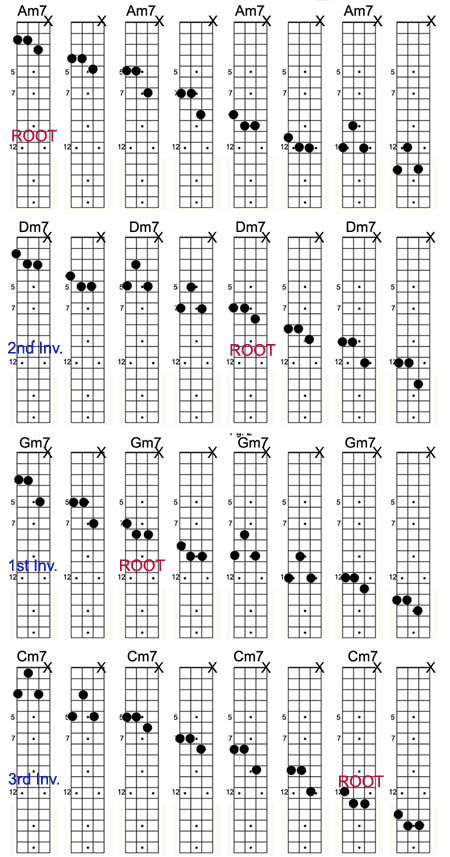
For you theory geeks, these are Root, 1st inv, 2nd inv, and 3rd inv. Recall, in mandolin chording, the bass note is kind of irrelevant because it's being sound out by a lower instrument in the ensemble. Our point was to let you know with 7th chords, there are only 4 inversions. If you were to go up a hypothetic neck of infinity, each of them would repeat again, 12 frets up (one octave).
Ready for all your Modal jazz standards, including:
So What
Impressions
Maiden Voyage
Cantaloupe Island
Little Sunflower
Black Narcissus
Freedom Jazz Dance
Footprints
Take Five
Milestones
Recordame
Invitation
Bolivia
My Favorite Things
Posted by Ted at 7:07 PM
 February 19, 2015 | 7th Chord Streams up and down the fretboard
February 19, 2015 | 7th Chord Streams up and down the fretboard
We think one of our most overlooked treasures on the site is our two page PDF that TABs out all the inversions of the 7th chord in 3-note shapes. It even goes a step further and inserts a passing or "filler chord" that allows you to give motion to any long section of music that has multiple measure of V7.
Take a 12 bar blues pattern for example. In it's simplest form, you have three V7 chords. That's it!
Entire careers have been built on the ability to make this classic form interesting. It's great if you're soloing, but what if you're the poor sap that has to play chords behind that.
How boring...
D7 D7 D7 D7 D7 D7 D7 D7
G7 G7 G7 G7 G7 G7 G7 G7
D7 D7 D7 D7 D7 D7 D7 D7
G7 G7 G7 G7 G7 G7 G7 G7
etc...
Not really, though. With the patterns we've mapped out, everything changes. Not only can you get your sanity back, you can amaze and impress your friends with these chord variation "streams" of V7.
How do you go about learning them? We recommend you be just as versed playing them down the neck (starting in the high frets) as you do going up, but that takes practice. Take them in chunks:
Novice Level:
1. Play two strokes per chord.
2. Play them in pairs. 1 & 2, 3 & 4, 5 & 6, 7 & 8.
3. Play them in two pairs, 1 2 3 4, 3 4 5 6, 5 6 7 8, etc.
Intermediate Level:
1. Play them in sets of pairs, up and down.
2. Start on the higher frets and work backwards
Advanced Level:
1. Start transposing to other keys.
2. Apply to songs.
Download PDF: 7th Chord Streams

Don't stop there! Transpose them up a fret or two, or down one.
Ab blues anyone?
Posted by Ted at 2:16 PM
 February 12, 2015 | Best of JM: 'I vi ii7 V7' 3-note chord blocks
February 12, 2015 | Best of JM: 'I vi ii7 V7' 3-note chord blocks
Enjoy the popular archive material below.
From January 17, 2013 | 'I vi ii7 V7' 3-note chord blocks
In our series of Vamps, we looked at movable blocks of 3-note chord patterns, how they could fill in gaps of long, static areas of progressions. We took the same approach to V7, Minor7, and Major7 in all the possible inversions. If you haven't already, you should spend some time with these and try to get them into the subconscious of your fingers. (See links below.) The meatier lower three strings of your mandolin (especially if you're wielding a 5-string) can give you a strength to your accompaniment duties, and as we mentioned, set you up for some logical steps to chord melody when you add the E string.
We've previously introduced a very common chord progression in our FFcP series, the 'I vi ii7 V7' pattern we want to exploit in a chord state. Recall, they're broken arpeggios in the exercise, and the goal was to get this sound rooted in your ear through repetitive motor conditioning. It's a pattern you hear in Rock (think Doo Wop), ballad (think "Heart and Soul," "I Can't Get Started," "Why Do Fools Fall in Love," etc.), and tons of other pop music.
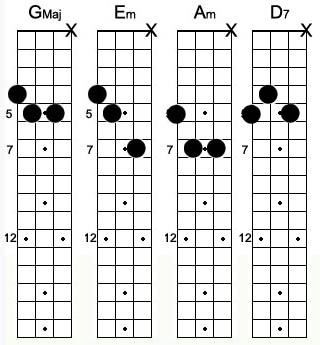
These are great for economy of movement. You may have learned other inversions, but this combination works well because none of the chord members every have to move more than a couple frets. Once they are comfortable, try moving down two frets for the key of F (FMaj Dm Gm C7), and up two frets for the key of A (Amaj F#m Bm E7). Of course you can go in between for F#, and Ab, as well as move the patterns all the way up the neck until you run out of frets (or good, clean tone).
Tackle another inversion:

Again, a simple economy of motion, and an opportunity to move down two frets for BbMaj, up two for Dmaj, the keys in between, and as high up the frets as you want. The third:
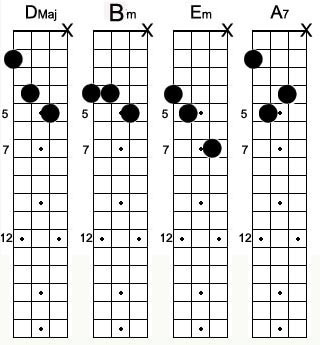
You don't have room to move this down more than one fret unless you use the open strings, but you certainly can move the blocks on up. You're probably wondering why we haven't used more m7 for the minor keys, and this decision was arbitrary. Feel free to add and subtract the 7th chord of these (i.e. GMaj7, Am7) at will; the function will still be the same.
This gives us the excuse to introduce a "color" version of the 'I vi ii7 V7' 3-note chord blocks. Don't worry about the theory if you don't want to, just bask in the radiance of the sounds of these chords:
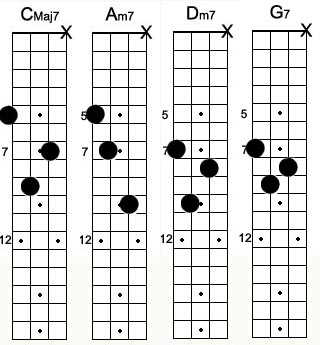
You have even more range to move this around. You can even move any of the four blocks across a string if you don't mind a more treble sound. The only problem in comping is sometimes you can interfere with the soloist playing in his/her register. Be sensitive to that.
Enjoy these? You can also implement them in areas that are more static. Let's say you have a four bar pattern C C G7 G7. You inject the Am7 and Dm7 and play C Am7 Dm7 G7, and everything should fit nicely. Use them to expand areas of harmonic "wilderness."
Here's a printable PDF you can use for reference:  'I vi ii7 V7' 3-note chord blocks 'I vi ii7 V7' 3-note chord blocks
Further
Vamps. Creating energy with Diatonic triads
Vamps. Expanding the Diatonic triads
Vamps. Minor modal
Static Changes: Connecting Chords
7th Chord Streams. Under the hood
Posted by Ted at 2:55 PM
 February 5, 2015 | Tenor Guitar & Tenor Banjo Chords
February 5, 2015 | Tenor Guitar & Tenor Banjo Chords
We've been digging into variations of the 5ths tuned tenor range incarnations of the mandolin family. CGDA is a great register for accompaniment and offers a much more interesting partnership with voice and soprano instruments. You can always play higher up the fretboard, but a mandolin can never play lower than a G.
Many may not be aware that the mandolin's bigger sister, the mandola is tuned the same as a tenor guitar and (Irish) tenor banjo. There is a rich tradition of both these instruments in mid early 20th century ensembles, banging out rhythm and often setting up a rich, sonorous harmonic foundation--often with just 3 or 4-note chords.
Tenor banjo/guitar books can help introduce chords to mandola, but an important consideration is scale. The tenor guitar scale can be as long as 23-26", and the mandola is generally 16-1/2 to 18", with the tenor banjo somewhere in between. Don't expect every chord to work identically from mandola to tenor--that fret span can be a killer on the fingers.
Check out the beta version of the Mandolin Cafe's latest expansion of mandolin and mandola chords into the tenor banjo and guitar. They are tuned the standard CGDA (not Octave GDAE). We recommend trying to learn these the same way you first learned mandolin chords. Begin simply, chords with just a few variations, but learn them as simple patterns of block finder movement. Avoid thinking "one 5th lower than mandolin" or transposing notes down a 5th. Think of it as 'that chord' until it becomes automatic.
Visit Cafe Link: Tenor Guitar & Tenor Banjo Chord Generator
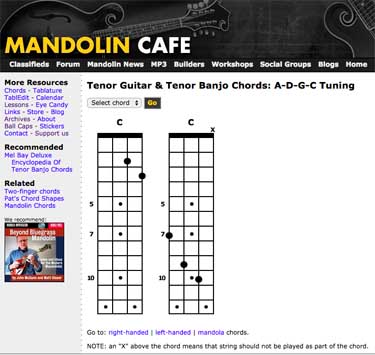
You might notice some of the "Bluegrass" fingerings are conspicuously absent, the infamous "G-chop," for example. The simple reason is the fretspan is unattainable for most human hands. Another good reason is doubling the 3rd of the chord in this register sounds horrible.
Another thought--if you're tackling learning a 5-string mandolin, we suggest taking the approach of conceptualizing this as a mandola with extension--a high E string. Don't think mandolin with range a 5th lower. Try learning it the same way you first learned the mandolin, a few chords at a time on some simple, familiar songs. Eventually they become automatic.
CDGA is your base. E is the extension
Further:
Mandolin Family Specs
Resources for Mandola
Sample Stock ii V7 I Mandola Chord Fingerings
5-string Mandolin Chord Sets: Major 'ii7 V7 I"
Posted by Ted at 9:38 PM

Disclaimer: In the 'Information Age' of the 21st Century,
any fool with a computer, a modem, and an idea can
become a self-professed 'expert." This site does not
come equipped with 'discernment.'
|



